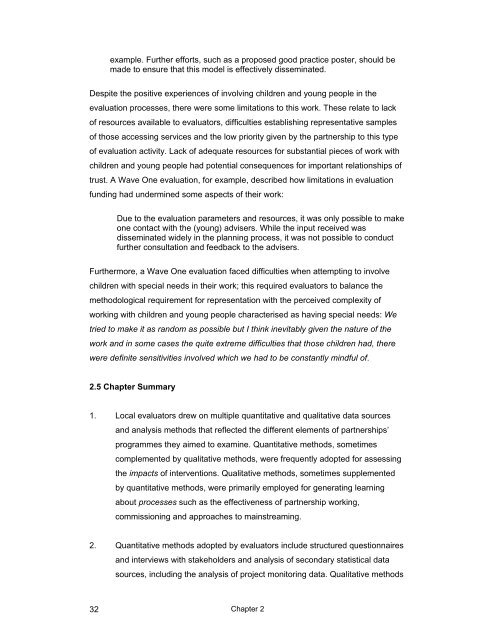Local Evaluation of Children's Services Learning from the Children's ...
Local Evaluation of Children's Services Learning from the Children's ...
Local Evaluation of Children's Services Learning from the Children's ...
- No tags were found...
You also want an ePaper? Increase the reach of your titles
YUMPU automatically turns print PDFs into web optimized ePapers that Google loves.
example. Fur<strong>the</strong>r efforts, such as a proposed good practice poster, should bemade to ensure that this model is effectively disseminated.Despite <strong>the</strong> positive experiences <strong>of</strong> involving children and young people in <strong>the</strong>evaluation processes, <strong>the</strong>re were some limitations to this work. These relate to lack<strong>of</strong> resources available to evaluators, difficulties establishing representative samples<strong>of</strong> those accessing services and <strong>the</strong> low priority given by <strong>the</strong> partnership to this type<strong>of</strong> evaluation activity. Lack <strong>of</strong> adequate resources for substantial pieces <strong>of</strong> work withchildren and young people had potential consequences for important relationships <strong>of</strong>trust. A Wave One evaluation, for example, described how limitations in evaluationfunding had undermined some aspects <strong>of</strong> <strong>the</strong>ir work:Due to <strong>the</strong> evaluation parameters and resources, it was only possible to makeone contact with <strong>the</strong> (young) advisers. While <strong>the</strong> input received wasdisseminated widely in <strong>the</strong> planning process, it was not possible to conductfur<strong>the</strong>r consultation and feedback to <strong>the</strong> advisers.Fur<strong>the</strong>rmore, a Wave One evaluation faced difficulties when attempting to involvechildren with special needs in <strong>the</strong>ir work; this required evaluators to balance <strong>the</strong>methodological requirement for representation with <strong>the</strong> perceived complexity <strong>of</strong>working with children and young people characterised as having special needs: Wetried to make it as random as possible but I think inevitably given <strong>the</strong> nature <strong>of</strong> <strong>the</strong>work and in some cases <strong>the</strong> quite extreme difficulties that those children had, <strong>the</strong>rewere definite sensitivities involved which we had to be constantly mindful <strong>of</strong>.2.5 Chapter Summary1. <strong>Local</strong> evaluators drew on multiple quantitative and qualitative data sourcesand analysis methods that reflected <strong>the</strong> different elements <strong>of</strong> partnerships’programmes <strong>the</strong>y aimed to examine. Quantitative methods, sometimescomplemented by qualitative methods, were frequently adopted for assessing<strong>the</strong> impacts <strong>of</strong> interventions. Qualitative methods, sometimes supplementedby quantitative methods, were primarily employed for generating learningabout processes such as <strong>the</strong> effectiveness <strong>of</strong> partnership working,commissioning and approaches to mainstreaming.2. Quantitative methods adopted by evaluators include structured questionnairesand interviews with stakeholders and analysis <strong>of</strong> secondary statistical datasources, including <strong>the</strong> analysis <strong>of</strong> project monitoring data. Qualitative methods32Chapter 2
















